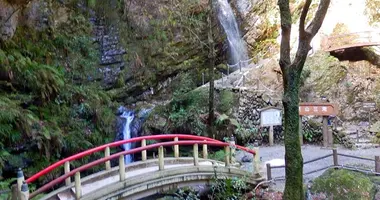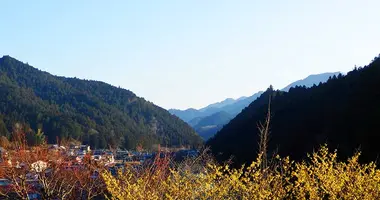Mount Oyama: A spiritual and scenic hiking destination near Tokyo

Walking up to the shrines on Mount Oyama, Kanagawa
Nestled in the heart of Kanagawa Prefecture, Mount Oyama stands as a beacon for nature lovers and spiritual seekers alike. This 1,252-meter peak, part of the Tanzawa-Oyama Quasi-National Park, offers a perfect escape from the bustling streets of Tokyo. With its rich history dating back over 2,200 years, Mount Oyama has long been revered as a sacred mountain, attracting pilgrims and hikers from far and wide. Today, it continues to captivate visitors with its blend of natural beauty, religious significance, and accessible hiking trails. Whether you're seeking a challenging climb or a peaceful retreat, Mount Oyama promises an unforgettable experience just a stone's throw from Japan's capital.
Overview of Mount Oyama
Mount Oyama, located about 60 kilometers west of Tokyo, is a prominent feature of Kanagawa Prefecture's landscape. Known as "Afuri-yama" or "Rainfall Mountain" due to its often cloud-shrouded peak, Oyama has been an important spiritual site for millennia. The mountain is home to the Oyama Afuri Shrine, a complex with a history spanning over 2,000 years. This shrine, dedicated to the gods of rain, mountains, and sake, has played a crucial role in the mountain's religious significance.
During the Edo period, Mount Oyama became a popular pilgrimage site, with up to 200,000 visitors annually. This tradition, known as "Oyama-mairi," has been recognized as part of Japan's cultural heritage. Today, the mountain attracts a diverse crowd of hikers, nature enthusiasts, and those seeking spiritual experiences. Its relatively accessible location and variety of trails make it an ideal destination for both seasoned hikers and beginners looking to escape the city for a day.
Getting to Mount Oyama
Accessing Mount Oyama is straightforward, thanks to its proximity to Tokyo and well-connected public transportation. The journey begins at Shinjuku Station, one of Tokyo's major transport hubs. From here, take the Odakyu Line to Isehara Station, a trip that takes about an hour. Once at Isehara, head to bus stop number 4 and board the bus bound for the Oyama Cable Car station. This 30-minute bus ride takes you through picturesque countryside before depositing you at the base of the mountain.
For a more cost-effective and convenient option, consider purchasing the Tanzawa-Oyama Freepass. This pass covers your round-trip train fare from Shinjuku, the bus to the cable car station, and even the cable car ride itself if you opt for the more comprehensive version. It's an excellent value for those planning to use all these modes of transport. Upon arriving at the cable car station, you'll find yourself at the start of the hiking trails and the Koma Sando, a charming shopping street leading up to the cable car.

View over the Tanzawa-Oyama Quasi-National Park, Kanagawa
Hiking trails and difficulty levels
Mount Oyama offers a variety of hiking trails to suit different fitness levels and preferences. The main hiking routes are known as the "men's trail" (otoko-zaka) and the "women's trail" (onna-zaka), though these designations are more traditional than prescriptive. The men's trail is steeper and more direct, while the women's trail is slightly longer but less steep, featuring several interesting stops along the way.
For beginners or those short on time, the women's trail offers a more gradual ascent with attractions like the "Seven Wonders," a series of small power spots believed to have magical properties. This trail passes by Oyama-dera Temple before joining up with the men's trail near the Afuri Shrine. More experienced hikers might prefer the challenge of the men's trail, which provides a more strenuous climb directly to the shrine.
From the Afuri Shrine, hikers can continue to the summit, a journey that takes about two hours each way. This upper section of the trail can be quite steep and rocky, requiring a good level of fitness. The total hiking time from the base to the summit and back can take 4-5 hours, depending on your pace and the number of stops you make. Remember to start early, especially if you plan to reach the summit, as the cable car's last departure is typically around 5:00 PM on weekends and 4:30 PM on weekdays.

Hiking through the cedar forests, Mount Oyama, Kanagawa Prefecture
Cable car and alternative ascent options
For those who prefer a less strenuous journey or are short on time, the Oyama Cable Car offers a convenient alternative to hiking the lower portion of the mountain. This funicular railway, which has been in operation for nearly a century, whisks passengers up 278 meters in elevation over its 0.8-kilometer length. The journey takes just 6 minutes and provides spectacular views of the surrounding landscape.
The cable car has two stations: the lower Oyama Cable Station and the upper Afuri Shrine Station. There's also an intermediate stop at Oyama-dera Temple, allowing visitors to explore this historic site before continuing their ascent. The cable car operates from 9:00 AM to 5:00 PM on weekends and holidays, and until 4:30 PM on weekdays. Departures are every 20 minutes, ensuring minimal wait times.
While the cable car offers a quick and easy way up, it's worth noting that even reaching the lower cable car station requires climbing a significant number of stairs. This approach, known as the Koma Sando, is lined with traditional shops and eateries, offering a glimpse into the area's rich cultural heritage. For those who choose to use the cable car, it's still possible to enjoy a hike by taking the trails from the upper station to the summit, combining the convenience of the cable car with the experience of mountain hiking.
Religious significance and spiritual attractions
Mount Oyama's religious importance dates back millennia, with evidence of ritual practices dating to the Jomon period (14,000-300 BCE). The mountain's primary spiritual center is the Oyama Afuri Shrine, a complex that includes both lower and upper shrines. The lower shrine, located near the cable car's upper station, is the more accessible and frequently visited of the two. It offers stunning views and houses several important religious artifacts.
The shrine is dedicated to several deities, including Ame-no-minakanushi, the central god of Shinto, and Oyamatsumi-no-kami, the god of mountains. Visitors can participate in various rituals, including the purification ceremony using the sacred spring water available at the shrine. The upper shrine, located at the mountain's summit, is smaller but holds significant spiritual power.
Another key spiritual site is Oyama-dera Temple, a Buddhist complex founded in 755 CE. This temple houses a rare iron statue of Fudo Myoo, an important Buddhist deity, which is only displayed on certain days of the month. The temple grounds also feature numerous statues and monuments, including depictions of tengu, mythological creatures associated with mountains.
One unique spiritual tradition at Mount Oyama is the "Osamedachi" custom, where visitors offer wooden swords at the shrine. This practice, said to date back to the 12th century, is believed to bring good fortune and success. The mountain's spiritual significance is further emphasized by the numerous smaller shrines and sacred spots dotting the hiking trails, each with its own legends and blessings.

Pagoda and shrines line the trails up Mt. Oyama, Kanagawa
Scenic views and natural beauty
Mount Oyama's appeal extends beyond its spiritual significance to its breathtaking natural beauty and panoramic views. As hikers ascend the mountain, they're treated to an ever-changing landscape of lush forests, rocky outcrops, and sweeping vistas. The mountain is particularly renowned for its autumn foliage, when the slopes are ablaze with vibrant reds, oranges, and golds.
From various points along the trails and especially from the summit, visitors can enjoy spectacular views that stretch across the Kanto plain. On clear days, it's possible to see as far as Tokyo, Yokohama, and even Mount Fuji in the distance. The Afuri Shrine offers a particularly impressive vantage point, with its views having been awarded two stars in the Michelin Green Guide Japan.
Nature enthusiasts will appreciate the diverse flora and fauna found on the mountain. The lower slopes are dominated by deciduous forests, giving way to evergreens at higher elevations. Wildlife sightings might include Japanese macaques, various bird species, and even the occasional deer. The mountain is also home to several notable natural features, including the picturesque Niju-no-taki waterfall, which can be seen along one of the descent routes.
For those interested in geology, Mount Oyama offers insights into the volcanic history of the region. The mountain is composed of non-alkali mafic rock dating back 7-15 million years, formed when this area was still under the sea. This geological legacy contributes to the mountain's unique shape and the challenging rocky terrain encountered on some of the hiking trails.

Autumn leaves up Oyama, Kanagawa Prefecture
Practical tips for visiting Mount Oyama
To make the most of your visit to Mount Oyama, consider the following practical tips:
- Timing: The best times to visit are late spring through early autumn. Avoid rainy season (typically June) and be prepared for crowds during peak autumn foliage season.
- Clothing: Dress in layers and wear sturdy hiking shoes. The temperature can be significantly cooler at the summit compared to the base.
- Supplies: Bring plenty of water, snacks, and a first-aid kit. While there are shops and vending machines along the way, they become scarcer as you ascend.
- Map: Pick up a free English map at the tourist information center near the cable car station.
- Start early: If planning to hike to the summit, start your journey early to ensure you have enough time to descend before the last cable car.
- Respect the environment: Follow the principles of Leave No Trace. Carry out all trash and stay on designated trails.
- Cultural sensitivity: Remember that Mount Oyama is a sacred site. Be respectful at shrines and temples, and follow any posted guidelines.
- Try local specialties: Don't miss the chance to taste Oyama's famous tofu dishes at one of the restaurants along Koma Sando or near the shrines.
- Check the weather: Mountain weather can be unpredictable. Check the forecast and be prepared for sudden changes.
- Consider staying overnight: For a more immersive experience, look into staying at one of the traditional inns near the mountain.
With its rich history, stunning natural beauty, and accessibility from Tokyo, Mount Oyama offers a perfect blend of spirituality, nature, and adventure. Whether you're seeking a challenging hike, a cultural experience, or simply a peaceful retreat from urban life, Mount Oyama has something to offer every visitor. So lace up your hiking boots, pack your camera, and prepare for an unforgettable journey to one of Kanagawa's most treasured mountains.

















